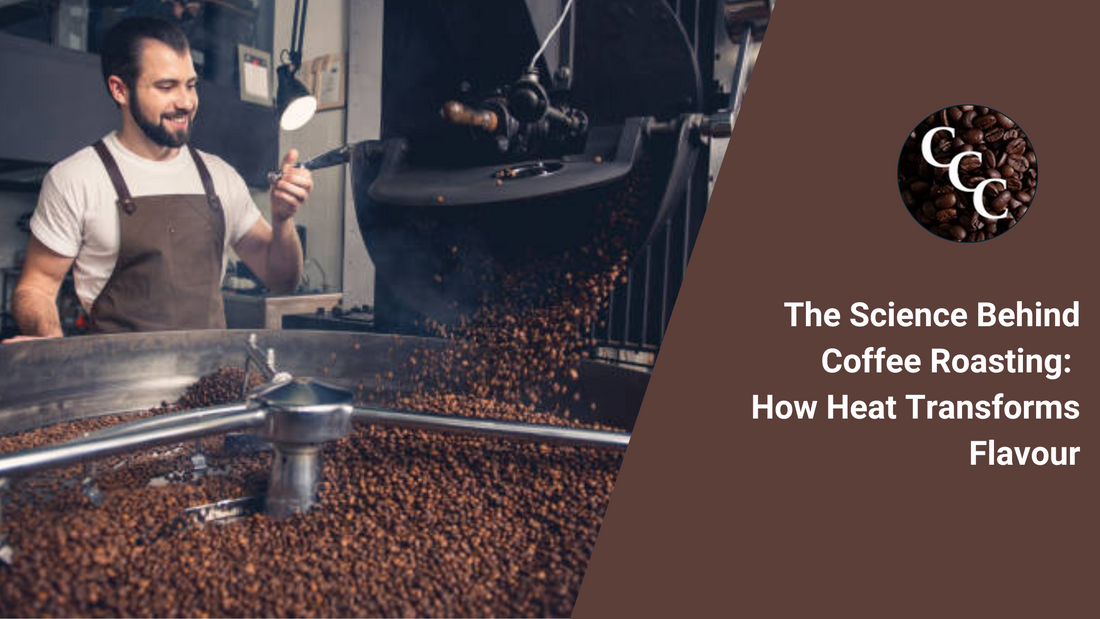There’s something magical about the moment freshly roasted coffee hits your nose. But behind that irresistible aroma is a world of science that transforms raw, green coffee beans into the richly nuanced brews we love. For those who seek out the finest beans and brew with care, understanding how heat shapes flavour is an essential part of the journey. Coffee roasting is not merely a step in production, it’s where chemistry, physics, and artistry collide.

The Science Behind Coffee Roasting: How Heat Transforms Flavour
Share
The Science Behind Coffee Roasting: How Heat Transforms Flavour
What Happens During Coffee Roasting?
Coffee roasting is a chemical and physical process that applies heat to green coffee beans, transforming their colour, aroma, density, and most importantly, flavour. Roasting typically occurs at temperatures between 180°C and 240°C, with each roast level (from light to dark) producing distinct taste profiles.
The Three Phases of Roasting:
1. Drying Phase: Moisture is driven out of the beans. This phase prepares the beans for the chemical reactions to follow.

2. Maillard Reaction Phase: Here, amino acids and reducing sugars react to form hundreds of aromatic compounds. This reaction, named after French chemist Louis-Camille Maillard, is crucial for flavour and colour development.
3. Development (or Roasting) Phase: The beans reach their first crack, a physical popping sound that indicates the release of steam and gas. This stage determines the final flavour profile.
The Role of Heat in Flavour Development
Heat is more than just a tool for roasting; it’s the catalyst for flavour development. As heat penetrates the beans, it triggers a cascade of reactions, including:
Caramelization: Sugars within the bean break down and caramelize, contributing to sweet, nutty notes.
Pyrolysis: The decomposition of organic materials due to high heat. This is when oils rise to the surface, and smoky or bitter notes can emerge, especially in darker roasts.
Degassing: Gases like CO2 are produced and eventually released, impacting aroma and freshness.
The speed and consistency of heat application influence everything from acidity to body to aftertaste. That’s why experienced roasters monitor temperature curves carefully, often using software and sensors.
Light, Medium, and Dark Roasts: What Changes?
For specialty coffee lovers, light and medium roasts are often preferred because they showcase the bean's terroir: the flavours influenced by the coffee’s growing region, altitude, and processing method.
Each roast level represents a different stage in the bean's chemical transformation:
- Light Roast: Bright acidity, floral and fruity notes, more pronounced origin characteristics. Minimal caramelization.
- Medium Roast: Balanced acidity and body, with richer, deeper flavours. The Maillard reaction is well-developed.
- Dark Roast: Bold, smoky, sometimes bitter with lower acidity. Origin nuances are often masked.
How Roasters Control Flavour
Roasters have several variables at their disposal to influence the final cup:
- Roast Time: Longer roasts can lead to more caramelized, mellow flavours, while shorter roasts preserve acidity.
- Temperature Curve (Roast Profile): A precise curve controls how fast the bean heats up. Small adjustments can lead to big flavour differences.
- Airflow and Drum Speed: These affect heat distribution and bean movement, helping to prevent scorching or underdevelopment.
Art meets science here. While tools and data guide the process, a roaster's experience, senses, and intuition are irreplaceable.
Why Freshness and Roast Date Matter
Once roasted, coffee begins to oxidize and lose its aromatic compounds. For the best experience, coffee should be consumed within 2 to 4 weeks of roasting, depending on storage conditions. Specialty coffee enthusiasts often seek out small-batch roasters who date-stamp each bag.
Degassing also plays a role; freshly roasted beans release CO2, which can affect extraction. That’s why many recommend waiting 3 to 5 days post-roast before brewing.
Exploring the Art and Science Together
The beauty of coffee roasting lies in its fusion of precision and creativity. Each batch offers an opportunity to highlight the unique character of the beans while crafting a flavour profile tailored to the drinker's preferences. Whether you're a seasoned home roaster or simply curious about your favourite bag of beans, understanding the science behind coffee roasting deepens your appreciation for every cup.
Frequently Asked Questions (FAQs)
What is the Maillard reaction in coffee roasting?
It’s a chemical reaction between amino acids and sugars that creates complex flavour and aroma compounds, giving roasted coffee its distinctive taste.
How long does coffee roasting take?
Roasting typically takes 8 to 15 minutes, depending on the desired roast level and the roaster's method.
What is the first crack in coffee roasting?
It's a popping sound made when the beans release steam and gases. It signals a key transformation point in the roast.
Is light roast coffee more caffeinated than dark roast?
Yes, generally. Light roast retains slightly more caffeine by weight, although the difference is minimal.
Why does roast date matter in coffee?
Freshness impacts flavour. Coffee is best enjoyed within a few weeks of roasting, before it loses aromatic compounds and begins to stale.

